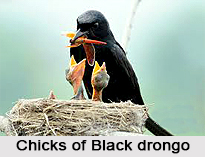 Black Drongo is an Indian Bird that bears a scientific name "Dicrurus macrocercus", and it is the resident breeder of tropical Asia, concentrated in Asian, South Asian and Pan Asian countries and also the Indian states.
Black Drongo is an Indian Bird that bears a scientific name "Dicrurus macrocercus", and it is the resident breeder of tropical Asia, concentrated in Asian, South Asian and Pan Asian countries and also the Indian states.
Family of Black Drongo
Black Drongo is a small Asian passerine bird of the drongo family Dicruridae. It is a common resident breeder in much of tropical southern Asia from southwest Iran through India and Sri Lanka east to southern China and Indonesia.
Colour of Black Drongo
Black Drongo is a wholly black bird with a distinctive forked tail and measures 28 cm (11 in) in length. Feeding on insects, it is common in open agricultural areas and light forest throughout its range, perching conspicuously on a bare perch or along power or telephone lines.
Behaviour of Black Drongo
Black Drongo is known for its aggressive behaviour towards much larger birds, such as crows, never hesitating to dive-bomb any bird of prey that invades its territory. This behaviour earns it the informal name of king crow. The smaller birds often nest in the well-guarded vicinity of a nesting black drongo. They are previously considered a subspecies (Dicrurus adsimilis macrocercus) of the African fork-tailed drongo (Dicrurus adsimilis), it is now recognized as a full species.
Introduction of Black Drongo
Black Drongo has been introduced to some Pacific islands, where it has thrived and become abundant to the point of threatening and causing the extinction of native and endemic bird species there.
Structure of Black Drongo
Black Drongo is glossy black with a wide fork to the tail. Adults usually have a small white spot at the base of the gape. The iris is dark brown (not crimson as in the similar ashy drongo). The sexes cannot be made apart in the field. Juveniles are brownish and may have some white barring or speckling towards the belly and vent, and can be mistaken for the white-bellied drongo. First-year birds have white tips to the feathers of the belly, while second-years have these white-tipped feathers restricted to the vent.
 Feeding of Black Drongo
Feeding of Black Drongo
Black Drongo is found predominantly in open country and usually perches and hunts close to the ground. They are mostly aerial predators of insects but also glean from the ground or off vegetation. They are found as summer visitors to north-eastern Afghanistan and northern Pakistan but are residents from the Indus Valley Civilisation until Bangladesh and into India and Sri Lanka. Some populations show seasonal movements that are poorly understood. The Black Drongo can be found in savannas, fields, and urban habitats.
Breeding of Black Drongo
Black Drongo breeds mainly during February and March in southern parts of India like Tamil Nadu, Karnataka, Telangana, Kerala and Andhra Pradesh and until August in other parts of the country. Males and females sing in the morning during the breeding season.
Courtship of Black Drongo
The courtship of Black Drongo can include aerobatic chases and they may lock their wings and beaks together, with the pair sometimes falling to the ground. Displays may be made on the ground. Pair bonds are retained for a whole breeding season. The nest is a cup made with a thin layer of sticks placed in the fork of branch, and is built in a week by both the male and female.
Eggs of Black Drongo
The eggs of Black Drongo are laid close to the first rains in April. The usual clutch is three or rarely four eggs laid in a cup nest placed in the fork of an outer branch of tree. Large leafy tree such as the jackfruit are preferred. The eggs are pale cream to red with spots and markings and are 26 mm long (1.05 in) and 19 mm wide (0.75 in). The eggs are incubated by both parents and hatch after 14 to 15 days. Nestlings are brooded for the first five days, after which the young are capable of maintaining a fairly constant body temperature. A second clutch may be laid if the first is destroyed.
Nests of Black Drongo
The nests of Black Drongo are sometimes built in telephone poles. A nesting territory of 0.003 to 0.012 km2 (0.3 to 1.2 hectares) is maintained.
 Young Black Drongo
Young Black Drongo
The young Black Drongo has a yellowish-red gape. The feather follicles appear on the fourth day and pin feathers emerge after a week. Nestlings increase in weight steadily until they are 12 days old. The eyes open on the eighth day, the iris reddish-black while the gape turns red. The young leave the nest after about 16 to 20 days after hatching. They do not have the fork in the tail until three weeks. The parents continue to feed and protect them for a month. Young birds may beg for food for longer, but are often ignored or chased away by the adults. Birds reach breeding condition in about two years.
Moulting of Black Drongo
In southern India, Black Drongo moults their feathers from June to October. The wing moult of Black Drongo begins in July with the first primary and proceeds towards the tenth. The secondaries of Black Drongo are replaced from August after the primaries are at the third quill. The secondary moult is not orderly, the 8th and 7th being dropped earlier than the rest. The tail feathers are moulted centrifugally.
Colour Change of Black Drongo
The seasonal colour changes of Black Drongo in the testicular tissues are caused by variation in melanin synthesis, with the dark pigmentation being lost during the breeding season.











